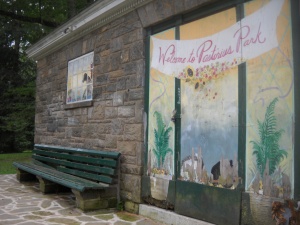“Chaque paysage est un état d’âme.” Henri-Frédéric Amiel, Swiss philosophy professor in the late 1800s wrote in his obsessively lengthy personal journal that “each landscape/countryside is a state of the soul/spirit.” I considered Amiel’s words as I meandered through Pastorius Park’s green amphitheater, built in 1915. This space is a sustainable rendition of an ancient theme, a modern version of an old world tradition. The dramatic place appeases the cultural tastes of the urban spirit while providing 16 acres of rolling country-like oasis. The green amphitheater is cultural and environmental: sustainable for the globe and society. Pastorius Park reifies the conditions of spirits both classical–set-in-stone–and relevant, modern, breathing, photosynthesizing.
Along Millman Street, by Hartwell in Northwest Philadelphia, we are welcomed by a dingy sign. Welcome to Pastorius Park!

Dogs are allowed here. This land is owned by Fairmount Park Commission. Boring, dirty sign. Small font. Let’s run right past it!
Pastorius Park is located in the Chestnut Hill neighborhood of Philadelphia, PA. Here is a “Bird’s Eye View” via Bing of the park, taken in winter. The evergreen trees stand in contrast to the bare deciduous trees.
There are no exterior borders or fences surrounding the park. This is an open park, surrounded by a grid of streets. There are no sidewalks around the perimeter. There are lined trees, a dominance of well-established plane trees.

Odd, old murals decorate bordered up windows of a defunct stone building. Again: Welcome to Pastorius Park!
Again: an odd mural.

Grassy carpeted terrace rolling down to the orchestra/moat surrounding the stage. This is one entrance among several identical entryways.
The amphitheater is close to Millman Street. The canopy is verdant now, in July. This is a green space amphitheater, not a hardscape amphitheater. Upper canopy trees and midcanopy trees are wall-like on one side; grass rolls around, allowing cooped-up city dogs to sprint about through and on the other side of the theater.

From the Mimosa/Silk Tree, spanning across the theater to a small, unused, stone building, note the gently-sloped terracing of the amphitheater.
The sloping lawn is navigable, easy to ascend and descend. The stairs, intermittently placed, are a formality, perhaps.
Upward perspective. Green prevails over grey, in sepia.

This design prioritizes green over grey. Why, however, must the stone stair structures be inserted? Perhaps to assert the function of the space, to orient the viewers’ collective gaze, a nod to classical axiality.
This is what the actors see, looking from their stage out into the audience.
Where is the color? There is little in mid-July here in this green space. There are no intentional herbaceous planting beds, no collections of containers, no sprays of color, no splashes of annuals. In fact, the lack of reds, pinks, purples, oranges surprised me, considering the location two blocks from Laurel Hill Gardens on Germantown Avenue near Abington Avenue and the neighborhood: Chestnut Hill. When I saw jewelweed in bloom, I couldn’t resist zooming in.

This is a volunteer splash of color. Nature offered this small yellow bloom; landscapers or horticulturalists did not install this plant.
At least 2 magnolia trees thrive in Pastorius Park and one is showing its color in mid-July. There are few specimen trees at the park.
Here is a link to a moveable camera, a 360-degree-and-more view of the park when dandelion bloom had just gone to seed, which I could not see in mid-July. Most striking is the preponderance of greenery: it’s everywhere. Green is what the people want. I suspect that if the locals here really want to get some color, some culture, they’ll pay money to go into an air-conditioned man-made building so they don’t have to sit on a blanket and get cramped-up knees. They’ll get a babysitter for the kids and wear new dry-clean-only outfits. But when the locals come to Pastorius Park, they are here to run with their dogs and children and lovers and frisbees. They are here to feel good about living in a city that provides them with a suburb’s amount of run-around space, uninterrupted by grey. Then again, how could anyone pass up free live music or Shakespeare a block away?
Here are some more photos I took in Pastorius Park, mid-July.

A species of Apple Tree, fruiting. Bench visible in background There are few benches in the entire park.
I noticed the orientation of all benches was away from all external roads, toward the nucleus of the park: the pond and the amphitheater. The benches illustrate Amiel’s point: the spirit of this park, the spirit of the people who frequent the park and who finance the park, (the very mind– “esprit”) is in search of more. To find more, to seek more than fulfillment at work, at home, in the city, Pastorius Park offers people a seat, albeit a hard-to-find hard bench–facing away from the city, toward more green, toward the water, toward a nucleus, toward the self, perhaps. This park exploits an “inward focus” as termed by Elizabeth Barlow Rogers in Landscape Design: A Cultural and Architectural History, in her discussion on early Western city planning.
Cucumber Magnolia (methinks) budding in July.
Here is a link from a recent concert at Pastorius Park with a photo gallery showing the vivacity of the public cultural green space.
Strolling through Pastorius Park, I wondered if Amiel implied that I would inform my interpretation of a landscape with the condition of my spirit. Or was he speaking generally: do the space-creators’ spiritual conditions direct the scope of the landscape? Do those who enjoy, who utilize, who beautify, who engage in the space have a soulful hand in a green space’s being? All of the above. From this space, I glean all of the above.









Pingback: Esherick – Site Analysis | our house is our world
Pingback: Margaret Esherick Addition – Final Documentation | our house is our world